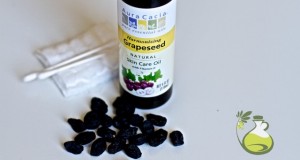
Photo credit: wikimedia
Walnut oil is received from the English walnuts by mechanic pressing. Walnut oil is light in color and has a delicate nutty aroma and flavor. There are three main walnut oil uses.
Culinary use
Walnut oil is edible oil. It is not as widespread in food preparation as other oils because it is expensive. However, as the oil is high in monounsaturated fats, omega-3 fats ad antioxidants this oil is very beneficial and we should add it to our diet. Walnut oil is not allowed to heat because its fatty acids break down and the oil becomes bitter and harmful. In addition, as Wikipedia notes, the heat destroys antioxidants abundant in walnut oil. This oil adds a specific tasty flavor to dishes and the culinary uses for walnut oil are numerous. The oil is used for:
- salad dressings (try tasty walnut oil salad dressing recipes),
- pasta sauces,
- meat and fish sauces,
- baking and desserts,
- cheese and bread dipping.
Remember adding walnut oil at the end of the cooking process when the dish is ready.
SEE ALSO: Find out Your Favorite amongWalnut Oil Recipes
Aromatherapy and skin treatment
Unsaturated fatty acids and antioxidants present in walnut oil make it a perfect choice for body massage. The oil possesses nourishing and moisturizing properties. It dries quickly and doesn’t leave a greasy feeling. Antioxidants protect the skin cells from harmful conditions and slow down the aging processes. One of widely-applied walnut oil uses is aromatherapy. The oil can be applied alone or in combination with other essential oils and acts as carrier oil. Walnut oil is considered to have a balancing effect on the nervous system. It is often diluted with tea tree oil (tea tree oil benefits are endless) and applied on wounds or used for treatment of skin diseases, for example, fungal infections, seborrheic dermatitis, eczema and warts. The oil is also used in skin and hair care products. It moisturizes and calms down the skin, prevents inflammation and dandruff.
RELATED: All Hemp Oil Uses You may Try
Artistic use
Artistic use is also mentioned in Wikipedia among the uses for walnut oil. The oil was used by the Renaissance painters. It was applied as a brush cleaner and paint thinner. Nowadays refined walnut oil is used to improve the gloss of paints; woodworkers prefer using walnut oil as a finish for goods that will be in contact with food, for example, wooden bowls or cutting boards. Walnut oil is mixed with beeswax in a proportion of 1:3. The oil is valued for its edibility.
Black walnut oil uses
Black walnut oil is derived from the different tree, but its properties are similar to the ones of walnut oil. So it can be used in the same way. We should only remember that the taste and flavor of black walnut oil is a bit stronger. That’s why one of the most popular of black walnut oil uses is flavoring desserts and bakery. It is added to cakes, muffins, smoothies and ice-cream. Some companies producing ice-cream admit that black walnut is their third-selling flavor.
If you decide to try one of the uses for walnut oil remember that the oil has a short shelf life after it is opened. So buy small bottles of it and keep in a refrigerator after opening.
 Oilypedia.com – Benefits And Uses Of Supplemental and Essential Oils
Oilypedia.com – Benefits And Uses Of Supplemental and Essential Oils 


